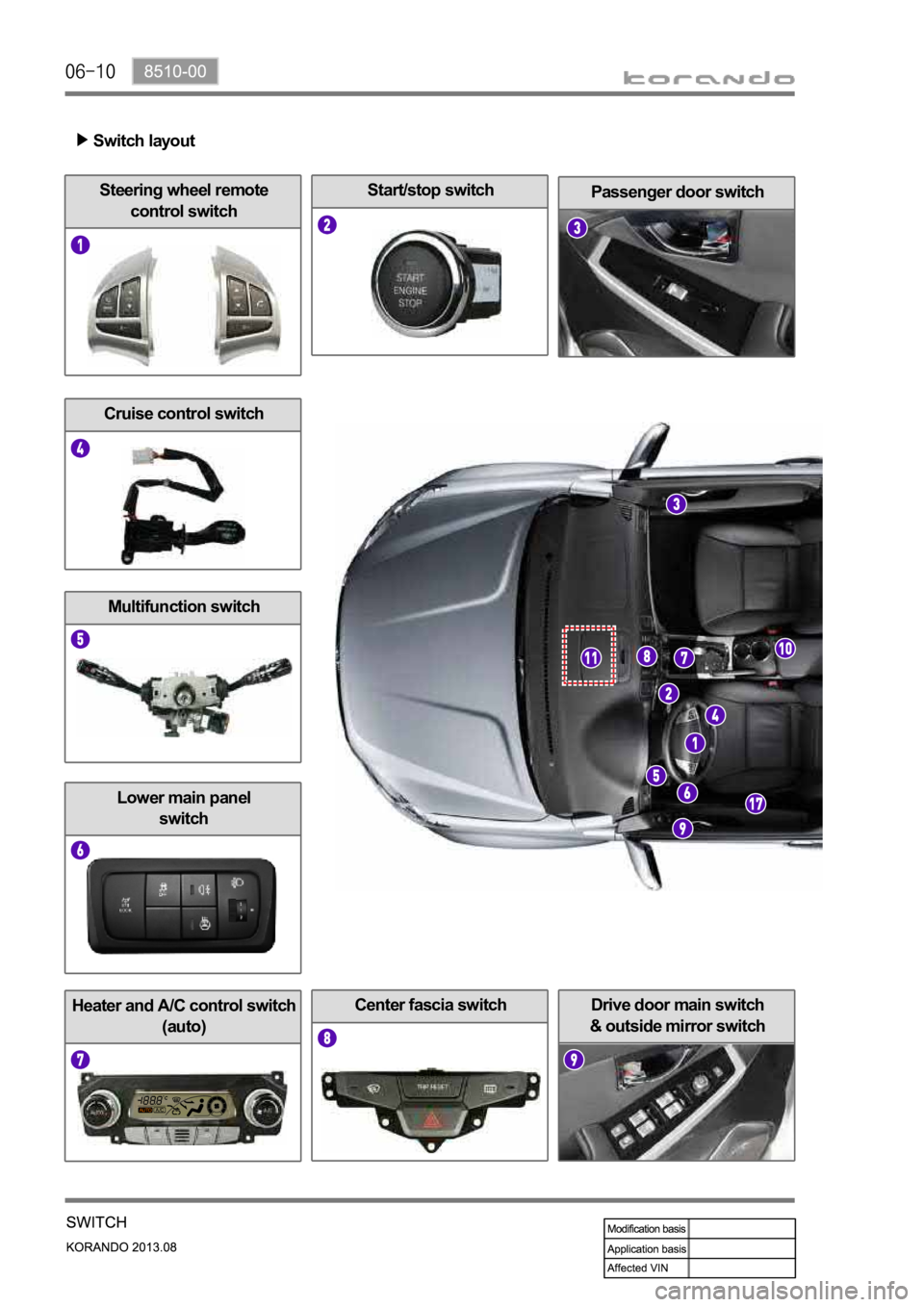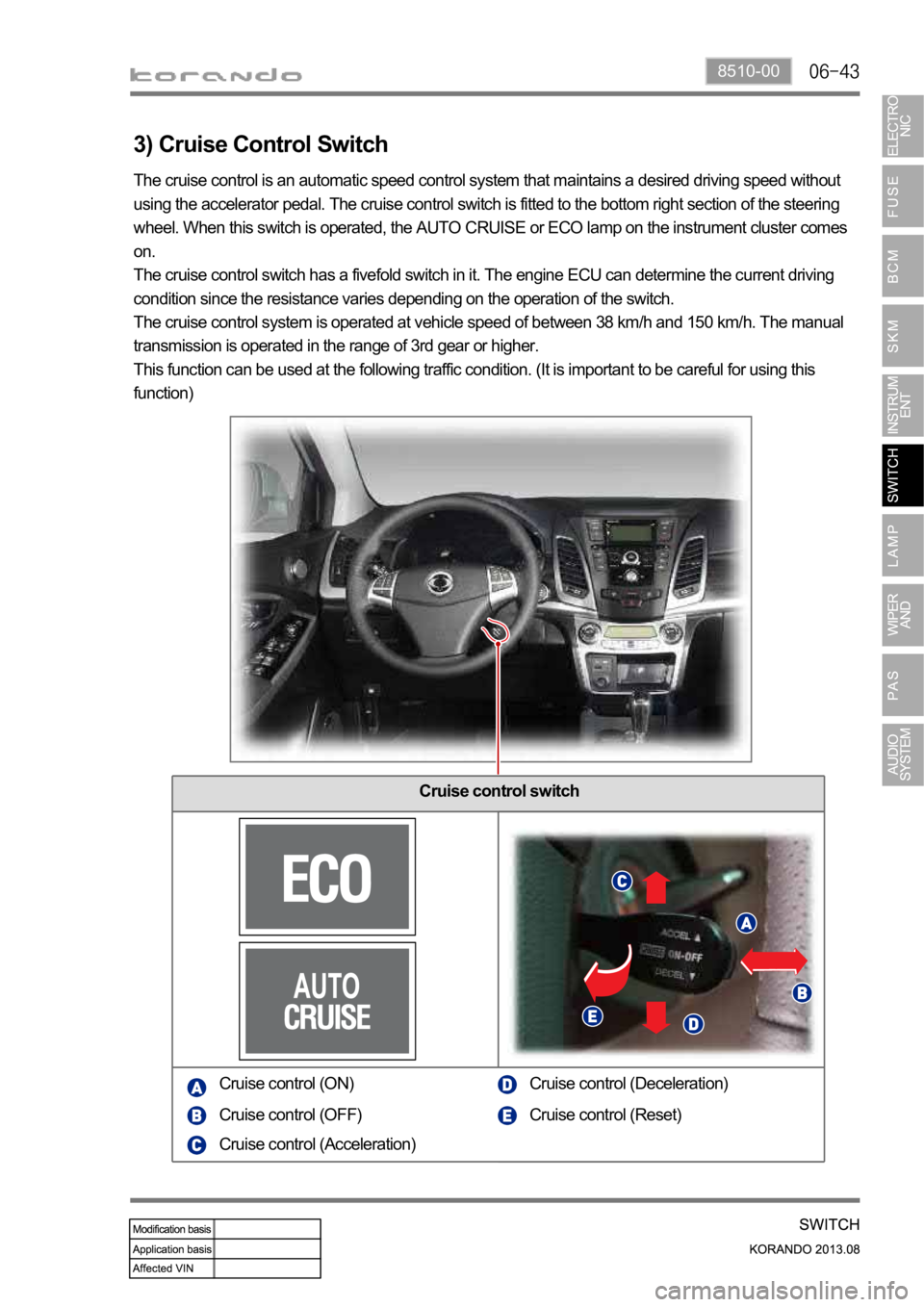cruise control SSANGYONG KORANDO 2013 Owner's Guide
[x] Cancel search | Manufacturer: SSANGYONG, Model Year: 2013, Model line: KORANDO, Model: SSANGYONG KORANDO 2013Pages: 1336, PDF Size: 92.18 MB
Page 838 of 1336

8510-00
Audio remote control switch
Cruise control switch
Item Specification
Cruise control switchON/OFF DC 5V - 10mA
DECEL DC 5V - 10mA
ACCEL DC 5V - 10mA
RESUME DC 5V - 10mA
Item Resistance Output voltage
Audio
remote control
switchVOL -
0 to 0.3 V
VOL +
0.4 to 1.0 V
MODE
1.1 to 1.4 V
MUTE
1.5 to 1.8 V
SEEK UP
1.9 to 2.25 V
SEEK DOWN
2.26 to 2.64 V
TIP -
-
TIP +
-
Bluetooth
(hands-free)
2.66 to 3.0 V
Front seat heating and ventilation switch
Item Specification
Front seat heating
and ventilation switchDriver seat heating switch 12V - 0.1A (max. 30 mA)
Driver seat ventilation switch 12V - 0.1A (max. 30 mA)
Passenger seat heating switch 12V - 0.1A (max. 30 mA)
Page 843 of 1336

Drive door main switch
& outside mirror switchHeater and A/C control switch
(auto)
Start/stop switchSteering wheel remote
control switch
Center fascia switch
Passenger door switch
Lower main panel
switch
Cruise control switch
Multifunction switch
Switch layout
Page 876 of 1336

8510-00
3) Cruise Control Switch
Cruise control switch
The cruise control is an automatic speed control system that maintains a desired driving speed without
using the accelerator pedal. The cruise control switch is fitted to the bottom right section of the steering
wheel. When this switch is operated, the AUTO CRUISE or ECO lamp on the instrument cluster comes
on.
The cruise control switch has a fivefold switch in it. The engine ECU can determine the current driving
condition since the resistance varies depending on the operation of the switch.
The cruise control system is operated at vehicle speed of between 38 km/h and 150 km/h. The manual
transmission is operated in the range of 3rd gear or higher.
This function can be used at the following traffic condition. (It is important to be careful for using this
function)
Cruise control (ON)
Cruise control (OFF)
Cruise control (Acceleration)Cruise control (Deceleration)
Cruise control (Reset)
Page 1016 of 1336

3) Shift Map Selection
The driver can manually select between normal (S) and winter modes (W) via the mode switch.
Depending on the transaxle temperature, uphill and downhill grades and altitude, shift maps will be
selected by the TCU to suit the driving conditions. The following maps are available.
Standard (Normal) Mode
Normal Mode is selected when the lever is in the D position with the mode switch in the normal (S)
position and the transaxle is within normal temperature ranges. Shift schedule points are optimised for
fuel efficiency and general driving conditions.
Uphill and Downhill Mode
In this mode, depending on the load of the vehicle, adaptive shift maps are selected to progressively
adjust the shift points and torque converter lock points.
Altitude Mode
Shift points are automatically adjusted at higher altitudes to compensate for changes in engine torque
where the torque produced by the engine is greatly reduced by the effects of reduced barometric
pressure and temperature.
Winter (W) Mode
When winter mode is selected, starting in second gear is facilitated and the WINTER mode indicator
light is switched ON. To prevent wheel spin on slippery surfaces, the transmission will not allow first gear
unless manually overridden.
Warm up Schedule
Hot Mode
converter lock-up is increased to prevent heat generation by the torque converter.
Activation of the hot mode inhibits other transmission performance features including uphill and downhill
compensation and altitude compensation. Some degradation in shift feel may be experienced as the
torque converter is not unlocked during shifting.
Cruise Control Mode
When cruise control is activated the engine ECU may request the transaxle to downshift under trailing
throttle conditions to increase engine braking.
the electrical radiator fans are switch ON
the engine torque will be reduced and the W light on the instrument cluster will flash
protection.